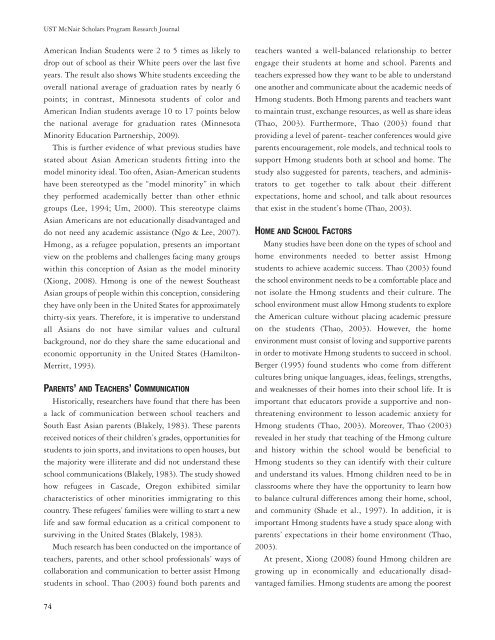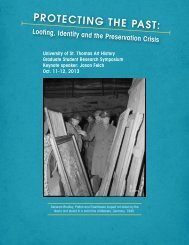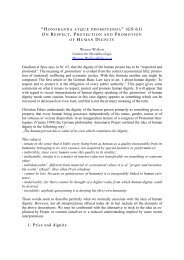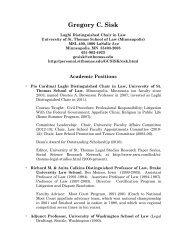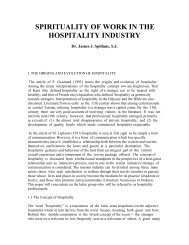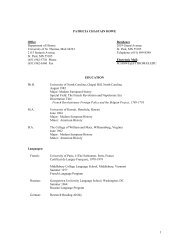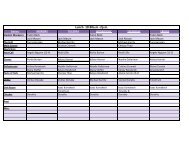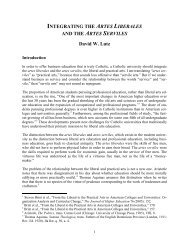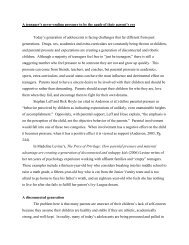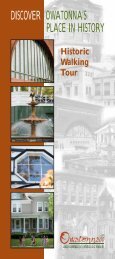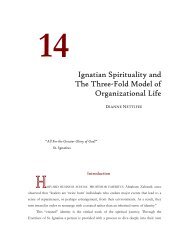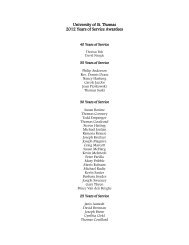dr. ronald e. mcnair acknowledgements - University of St. Thomas
dr. ronald e. mcnair acknowledgements - University of St. Thomas
dr. ronald e. mcnair acknowledgements - University of St. Thomas
You also want an ePaper? Increase the reach of your titles
YUMPU automatically turns print PDFs into web optimized ePapers that Google loves.
UST McNair Scholars Program Research Journal<br />
American Indian <strong>St</strong>udents were 2 to 5 times as likely to<br />
<strong>dr</strong>op out <strong>of</strong> school as their White peers over the last five<br />
years. The result also shows White students exceeding the<br />
overall national average <strong>of</strong> graduation rates by nearly 6<br />
points; in contrast, Minnesota students <strong>of</strong> color and<br />
American Indian students average 10 to 17 points below<br />
the national average for graduation rates (Minnesota<br />
Minority Education Partnership, 2009).<br />
This is further evidence <strong>of</strong> what previous studies have<br />
stated about Asian American students fitting into the<br />
model minority ideal. Too <strong>of</strong>ten, Asian-American students<br />
have been stereotyped as the “model minority” in which<br />
they performed academically better than other ethnic<br />
groups (Lee, 1994; Um, 2000). This stereotype claims<br />
Asian Americans are not educationally disadvantaged and<br />
do not need any academic assistance (Ngo & Lee, 2007).<br />
Hmong, as a refugee population, presents an important<br />
view on the problems and challenges facing many groups<br />
within this conception <strong>of</strong> Asian as the model minority<br />
(Xiong, 2008). Hmong is one <strong>of</strong> the newest Southeast<br />
Asian groups <strong>of</strong> people within this conception, considering<br />
they have only been in the United <strong>St</strong>ates for approximately<br />
thirty-six years. Therefore, it is imperative to understand<br />
all Asians do not have similar values and cultural<br />
background, nor do they share the same educational and<br />
economic opportunity in the United <strong>St</strong>ates (Hamilton-<br />
Merritt, 1993).<br />
PARENTS’ AND TEACHERS’ COMMUNICATION<br />
Historically, researchers have found that there has been<br />
a lack <strong>of</strong> communication between school teachers and<br />
South East Asian parents (Blakely, 1983). These parents<br />
received notices <strong>of</strong> their chil<strong>dr</strong>en’s grades, opportunities for<br />
students to join sports, and invitations to open houses, but<br />
the majority were illiterate and did not understand these<br />
school communications (Blakely, 1983). The study showed<br />
how refugees in Cascade, Oregon exhibited similar<br />
characteristics <strong>of</strong> other minorities immigrating to this<br />
country. These refugees’ families were willing to start a new<br />
life and saw formal education as a critical component to<br />
surviving in the United <strong>St</strong>ates (Blakely, 1983).<br />
Much research has been conducted on the importance <strong>of</strong><br />
teachers, parents, and other school pr<strong>of</strong>essionals’ ways <strong>of</strong><br />
collaboration and communication to better assist Hmong<br />
students in school. Thao (2003) found both parents and<br />
74<br />
teachers wanted a well-balanced relationship to better<br />
engage their students at home and school. Parents and<br />
teachers expressed how they want to be able to understand<br />
one another and communicate about the academic needs <strong>of</strong><br />
Hmong students. Both Hmong parents and teachers want<br />
to maintain trust, exchange resources, as well as share ideas<br />
(Thao, 2003). Furthermore, Thao (2003) found that<br />
providing a level <strong>of</strong> parent- teacher conferences would give<br />
parents encouragement, role models, and technical tools to<br />
support Hmong students both at school and home. The<br />
study also suggested for parents, teachers, and adminis -<br />
trators to get together to talk about their different<br />
expectations, home and school, and talk about resources<br />
that exist in the student’s home (Thao, 2003).<br />
HOME AND SCHOOL FACTORS<br />
Many studies have been done on the types <strong>of</strong> school and<br />
home environments needed to better assist Hmong<br />
students to achieve academic success. Thao (2003) found<br />
the school environment needs to be a comfortable place and<br />
not isolate the Hmong students and their culture. The<br />
school environment must allow Hmong students to explore<br />
the American culture without placing academic pressure<br />
on the students (Thao, 2003). However, the home<br />
environment must consist <strong>of</strong> loving and supportive parents<br />
in order to motivate Hmong students to succeed in school.<br />
Berger (1995) found students who come from different<br />
cultures bring unique languages, ideas, feelings, strengths,<br />
and weaknesses <strong>of</strong> their homes into their school life. It is<br />
important that educators provide a supportive and nonthreatening<br />
environment to lesson academic anxiety for<br />
Hmong students (Thao, 2003). Moreover, Thao (2003)<br />
revealed in her study that teaching <strong>of</strong> the Hmong culture<br />
and history within the school would be beneficial to<br />
Hmong students so they can identify with their culture<br />
and understand its values. Hmong chil<strong>dr</strong>en need to be in<br />
classrooms where they have the opportunity to learn how<br />
to balance cultural differences among their home, school,<br />
and community (Shade et al., 1997). In addition, it is<br />
important Hmong students have a study space along with<br />
parents’ expectations in their home environment (Thao,<br />
2003).<br />
At present, Xiong (2008) found Hmong chil<strong>dr</strong>en are<br />
growing up in economically and educationally disad -<br />
vantaged families. Hmong students are among the poorest


